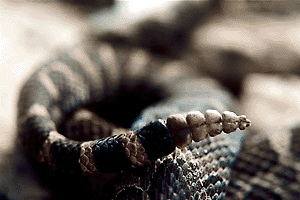How is the Massasauga Classified?
This graphic is a phylogenetic
tree I made on Microsoft Word that shows the classification of
the massasauga from Domain to Class based on morphology. Click
on the image to
make it larger. This image shows what groups the
massasauga falls into, but if you read on, you'll learn about
why it's in those groups.

This graphic shows some of the
closer relatives of the massasauga rattlesnake and its
sub-species. Click the image to view the classification
from the Class level on down to the sub-species level. I
made this chart in Microsoft Word as well, and it is also based
on morphological characteristics.

The massasauga rattlesnake is classified
as follows:
Domain: Eukarya Because
the massasauga’s cells have a true nucleus, membrane-bound
organelles, and multiply via mitosis.
Kingdom: Animalia This snake is considered an animal because it is multi-cellular, heterotrophic, motile in at least 1 stage of its lifecycle, and doesn’t have cell walls around its cells.
Phylum: Chordata It is considered a Chordate because it has a notochord (a rod down its dorsal side), pharyngeal pouches, an endostyle (basically a thyroid gland), a dorsal nerve chord, and a post-anal tail.
Class: Reptilia The massasauga is a reptile
because it has dry, rough scales made of keratin and its young
develop in amniotic eggs.
Order: Squamata The massasauga is a member
of this order because it has a transverse cloacal opening, a
highly moveable skull in comparison to other reptiles, and it
sheds its skin throughout its life.
 Family: Viperidae Massasaugas are considered to be
in this family because they have hollow fangs that fold back
into the mouth, venom, keeled scales (their scales have a small
ridge on them that give them a rough feeling), their scale
pattern and color are used for camouflage, a triangular head,
and they are ovoviviparous (their young are basically born
live).
Family: Viperidae Massasaugas are considered to be
in this family because they have hollow fangs that fold back
into the mouth, venom, keeled scales (their scales have a small
ridge on them that give them a rough feeling), their scale
pattern and color are used for camouflage, a triangular head,
and they are ovoviviparous (their young are basically born
live).
Genus: Sistrurus
Massasaugas have 9 enlarged scales at the top of their heads
which puts them into this genus. They are also referred to
as pygmy rattlesnakes, because they have a rattle on their tail.
heads
which puts them into this genus. They are also referred to
as pygmy rattlesnakes, because they have a rattle on their tail.
Species:
S. catenatus catenatus The scientific
name of the massasauga comes from the Latin words Sistrum
and oura which mean “rattle” and “tail” respectively, and
catenatus, which means chained. The chained part
describes the patterns on the back of the massasauga.
Ok, so now that you know how the massasauga is classified, why not learn more about where it lives by going on to the Habitat page? Click here!